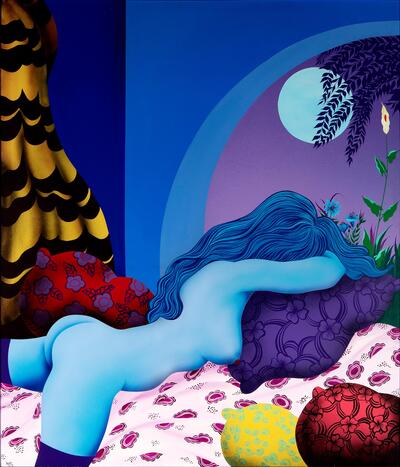Eduardo Úrculo: pop sensuality
A decisive creator in the configuration of the Spanish avant-garde, Eduardo Úrculo reached the summit of the so-called new figuration, thanks to pop art, a style in which his work manifested itself with a more daring and personal language.
After some beginnings dominated by the social expressionism of denunciation, Úrculo suffered a creative crisis that led him in 1966 to settle in the mecca of the hippy movement that at that time was Ibiza, an island where he undertook a new personal and creative stage that would mark a point of inflection and rupture with his previous work. A year later, during a trip to Stockholm, he discovered what he had been looking for so hard. The anthological exhibition where he could see the works of Warhol, Linchestein and Rauschenberg meant the beginning of his idyll with the postulates of pop art, revealing through him a neofiguration in which he could channel his most vital, playful, and ironic facet.
It was at this moment that, imbued by the music of Pink Floyd, the hippy philosophy and the optimistic spirit of the Pitusa island, life and its art resurfaced with a bewitching vitality and hedonism. From then on, his work adopted an aesthetic close to comics and advertising of enveloping lines and flat colors that gave birth to a stage defined as an erotic era that would span the last years of the 1960s until the end of the 1970s.
It will be then when the woman’s body takes on an absolute leading role in works that, like this one, hide a much more transgressive character than what it suggests at first glance. Taking into account the repressive political and social context of Francoist Spain, Úrculo blew up all the taboos around sexuality, whose freedom he exalted through a female body with suggestive postures and voluptuous forms of overflowing sensuality. Likewise, the marked contrasts of shape and color give a psychedelic air to interior spaces that will progressively be filled with baroque ornamentation and architecture with modernist roots.
Despite their evident eroticism, their images never reached the coarseness of the explicit. Hers is an interpretation of the female body close to that made by the surrealists where the woman’s face, devoid of any individualized trait, appears hidden between mirrors, curtains and fabrics to symbolize in her body the purest and most universal desire.
The vindictive nature of these works was endorsed by the artist himself when he confirmed that his paintings participated in the so-called sexual revolution, understood as a means of struggle and self-affirmation against the repression of the system. In fact, the first productions of this stage were dotted with scandal despite containing a discreet erotic charge, even experiencing censorship when his paintings were withdrawn from exhibitions such as the Hispano-American Biennial.
Sensory, sensual and vital, that was the world that Úrculo created, a universe that, as Juan Manel Bonet said, “seems touched by the sign of Eros”.






